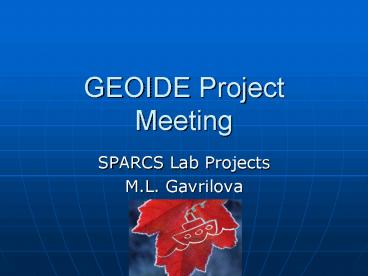GEOIDE Project Meeting PowerPoint PPT Presentation
1 / 25
Title: GEOIDE Project Meeting
1
GEOIDE Project Meeting
- SPARCS Lab Projects
- M.L. Gavrilova
2
Research goals
- Applications of computational methods in spatial
analysis - GIS real-time terrain modeling and visualization
- Using methods for selection of Lp norms as
alternative distance functions - Pattern matching and point pattern analysis using
computational geometry methods - Clustering analysis using k-neighbor approach
- Application of the Voronoi diagram and Delaunay
triangulation navigation problems
3
Students project participants
- 1. Russel Apu, Ph.D. program, Computer Science
Department, University of Calgary, since Winter
2005 - 2. Priyadarshi Bhattazhariya, M.Sc. program,
Computer Science Department, University of
Calgary, since Fall 2005 - 3. April Jensen, NSERC undergraduate research
award recipient, Summer 2005. - 4. Elia Palme, Patrick Terreaux, Technical
University of Froeberg, Switzerland, Summer-Fall
2005
4
Detailed Projects List
- M.Sc. student, Priyadarshi Bhattacharya is
working on the Route intersection and planning
using spatial neighborhood properties and
Delaunay triangulation. - Russel Apu, who has recently entered Ph.D.
program, concentrates his research on adaptive
memory subdivision and vision for strategic
motion planning and navigation. - April Jensen, NSERC undergraduate research award
winner, was investigating topological approaches
to risk analysis as well as graph based methods.
She has produced 3 reports during her period of
research on these two topics plus a literature
review on normal vs. abnormal behavour patterns
and their classifications. - 4. Two visiting students from Switzerland in the
last year of their thesis project Elia Palme and
Patrick Terreaux have implemented the ship route
visualization system and created corresponding
documentation on their web site.
5
Route Intersection Project
- 1. The intersection points of ship routes are
determined. - 2. Delaunay Triangulation is formed on
intersection and incident data. - 3. Clusters are formed using edge properties of
the Delaunay Triangulation. - 4. Clusters are approximated as convex hulls.
- 5. Reduced Visibility graph is constructed for
the convex and disjoint - polygonal obstacles.
- Priyadarshi Bhattachariya next step is to
integrate his software with MARIS data.
6
Program snapshot
7
Example of one of the queries
8
Adaptive Memory Subdivision Project (AMS)
- Russel Apu project concentrates on adaptive
memory subdivision and computer vision techniques
for strategic motion planning and navigation. - Applications include
- Interactive path planning
- Obstacle avoidance
- Terrain /shore line reconstruction
- Mapping applications
- Real-time visualization
- Contour detection
- Optimization
9
AMS GIS Visualization
10
DEM Digital Elevation Model
- Contains only relative Height
- Regular interval
- Pixel color determine height
- Discrete resolution
X
Kluanne National Park
Y
11
Converting Height field data into 3D topological
mesh
- Pixel value (z) is used as Height Map
- Vertices are generated as points in 3D
- A Mesh is triangulated
X
200
255
150
100
Y
100
255
255
200
200
150
200
100
12
ROAM Real-time Optimally Adapting Mesh
Developed by Mark Duchaineau, Lawrence Livermore
National Laboratory
Quad Tree
Triangle BIN Tree
- No cracks
- Reversible
- Efficient
- Adaptive
13
ROAM Contd
- Can Subdivide when more details necessary
- Merge Split Queue
- Tree Structured
14
Navigation project
- Use Sensor Data
- Use Threat Assessment/stimuli
- Use Adaptive Spatial Memory
- Compute Path from KB
- KB is represented by ASM
- Fast (Real-time)
- Adaptive and evolutionary
- Learning, experience
- Natural behavior
15
Navigation Configuration space
- Convert Complex configuration of Agent
- Degree of freedom
- Joints
- Shape
Minkowski's Sum
16
Navigation Current Methods
Voronoi Diagram
Raster Method
Potential Method
- Maximum Clearance
- Slow
- No other Consideration
- Effective for low Res.
- Impractical for Hi.Res.
- Local Minima
17
Navigation the Agent
- ASM based method defines the agent at strategic
and navigation stage
18
Image Distance Transform
- Smallest distance from obstacle
- Can be performed as a preprocessing
- Fast O(n2)
- Easy to obtain from range sensors
- Easy to compute c-space for agents with complex
shape - Algorithm also gives the coordinates of nearest
obstacle
19
Runtime Analysis
20
Risk Analysis Project
- April Jensen, NSERC undergraduate research award
winner, was investigating topological approaches
to risk analysis as well as graph based methods. - She has produced 3 reports during her period of
research plus a literature review on normal vs.
abnormal behavour patterns and their
classifications.
21
Risk Analysis
- April Jensen research reports address the
following topics - studied background information in GIS,
computational geometry and marine safety and
security (report prepared) - performed a literature review of methods used in
outlier and abnormal behavior detection (report
prepared). - performed a literature review of methods used in
modeling, storing and analyzing route data
(review paper prepared) - installed MARIS software for use in displaying
and analyzing shipping track and incident data - studied MARIS software including its capabilities
and functionality and prepared a short summary of
these (report) - explored the ArcGIS features for displaying and
analyzing shipping tracks and incident data. - identified computational methodology for the
analysis of data.
22
Route Visualization project
- Elia Palme and Patrick Terreaux have implemented
the ship route visualization system and created
corresponding documentation on their web site (a
pilot project to assist better understand the
route network). - Web site http//www.elia.ch/VT3DA/
23
Goals of the project
- 1. To interlink realistic 3D visualization with
MARIS data - 2. To display ship routes (or any specified
subset of them) - 3. To compute and visualize intersections
- 4. To perform queries such as window query (which
routes intersect given polygon), point query
(which route is nearest to a given point),
nearest-neighbor query (which subset of routes is
closest to a given point/segment) - To specify display options and different ways to
compute point coordinates (longitude/latitude)
24
Snapshot of the system
25
System interface

